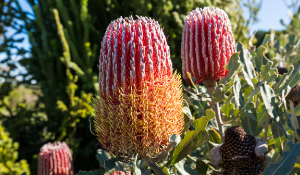Australian Natives are a fantastic addition to your garden to increase your garden biodiversity, inviting birds and beneficial insects in. They're also perfectly adapted to our harsh climate and can withstand some crazy conditions.
Bring the beauty of the bush to your backyard with some of our top picks for flowering Australian natives!
Acacias
.png?width=141&name=NTV%20(1).png) There are near on 1000 species of Acacias in Australia, commonly called Wattles, this is the largest genus of plants on our continent. It is even our national floral emblem; Acacia pycnantha to be exact.
There are near on 1000 species of Acacias in Australia, commonly called Wattles, this is the largest genus of plants on our continent. It is even our national floral emblem; Acacia pycnantha to be exact.
- Acacias come in ground cover forms and small and large shrubs and trees.
- This fast growing often short-lived native, depending on species will flower throughout the winter, spring and summer.
- Grow in full sun to semi shade with free draining soil. They often grow in very poor soils.
- Bee attracting.
Grevilleas
.png?width=141&name=NTV%20(2).png) Grevilleas would have to be one of the favourites of all flowering Australian native plants.
Grevilleas would have to be one of the favourites of all flowering Australian native plants.
- Grow in a sunny location
- Provide good drainage as grevilleas are susceptible to root rot if drainage is impeded.
- Grevilleas come in prostrate forms, shrubs of all sizes, right up to 25m tall ‘Silky oak’ Grevillea robusta and ‘White Oak’ Grevillea bailyeana.
- Wildlife and bee attracting
- Low phosphorus fertilisers (native formulated fertiliser) are a must to avoid phosphorus toxicity.
- Main flowering season is winter but many cultivars these days will also flower throughout the year.
Banksias
.png?width=141&name=NTV%20(3).png) Most of the 170 Banksia species flower throughout winter, including named cultivars.
Most of the 170 Banksia species flower throughout winter, including named cultivars.
- Banksias come in a range of sizes from ground covers, small to large shrubs, right up to large trees to 25m.
- Grow in a sunny location with well-drained soil. Prune lightly after flowering.
- Banksias must NOT be fertilised with any fertilisers high in phosphorus. Use a native formulated fertiliser.
- Use as cut flowers fresh and/or dried.
- Bee and bird attracting.
Check out your local garden centre to see which, species and varieties, will suit your garden and climate zone.
Looking for more great gardening info like this? Subscribe to the Better Earth Program to receive Better Earth Secrets Magazine direct to your inbox each season.
_MEB.png?width=842&height=596&name=RP_HorizontalColour(R)_MEB.png)



